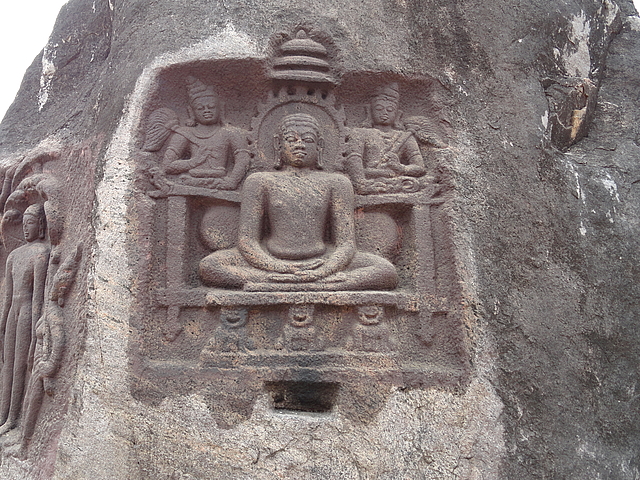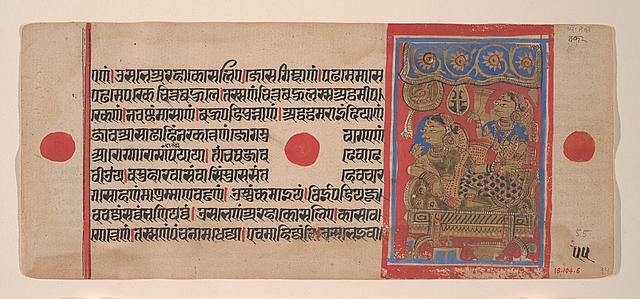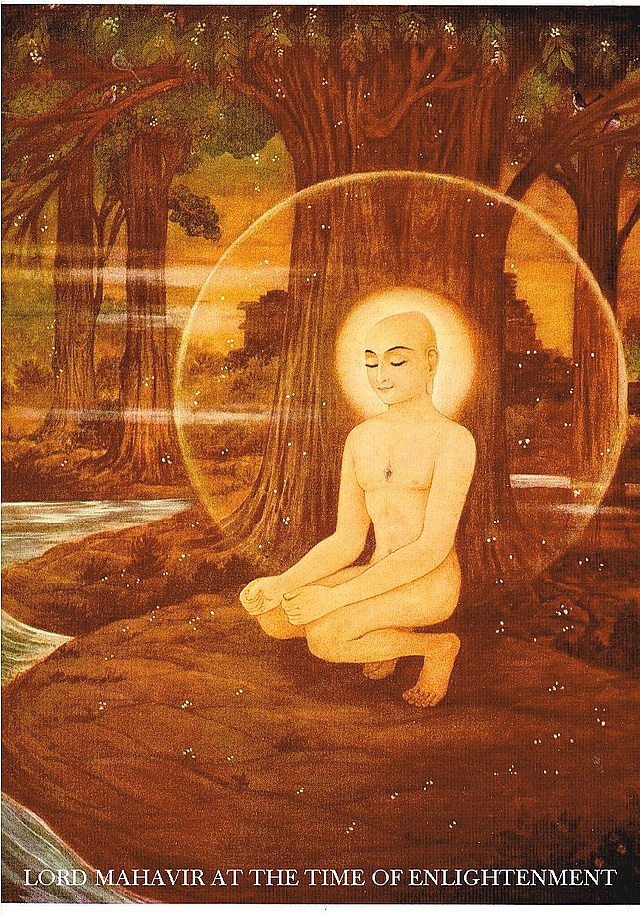
Rock carved Mahavira sculpture, Thirakoil, India.
Source: Wikimedia Commons at http://tinyurl.com/qjrvbl2
Why Teach and Learn about Jainism and the Life of Mahavira?
Apart from Buddhism, Jainism is the only other ancient non-Vedic Indian tradition that has survived until the present day. While Buddhism all but disappeared from India by the fourteenth century CE and was only later revived, Jainism has existed in India uninterruptedly for over 2,500 years. However, unlike Buddhism, it had not spread from India until recent times, which is largely due to the observance of the ethical principle of nonviolence. Careful attentiveness not to harm even the tiniest of living creatures prevented Jain mendicants - wandering monastics who own no property and obtain food by collecting alms - from using any means of transportation other than walking. This severely limited their travels, restricting their activities to India. Jainism has played a significant role throughout Indian history and remains an important component of religious and social life in present-day India. Chiefly involved in trade, Jains have been an affluent and powerful community, and despite the fact that Jainism is now a minority religion with about four million followers in India and between 100,000 and 200,000 in the diaspora, they continue to have authority and influence in contemporary society. Due to the great efforts of recent scholarship on Jainism, many of the myriad aspects of this rich tradition are studied and written about today. It is now more than ever possible to include Jainism in history and religious studies curricula. Such an inclusion allows a much more comprehensive understanding of India's past and present religious contexts in which Jainism has played a substantial part. In addition, Jainism's radical commitment to nonviolence and encouragement of ascetic practices makes the tradition interesting to explore in comparison to other world religions, as well as in ethical discussions.
In many ways, Jainism is a child of India. It agrees with a number of other Indian traditions in accepting the idea that embodied living beings have been trapped in the cycle of births, lives, deaths, and rebirths since beginningless times. This means that our current lives have been preceded by an infinite number of births in numerous possible life-forms, which for Jainism extend from heavenly, human, and infernal beings to animals, plants, earth-, water-, fire-, and air-bodied beings. Unlike Buddhism, Jainism accepts the existence of jivas, that is, souls or conscious immaterial substances that continually pass from one bodily form to another. There is no personal God or divine principle that oversees these processes and the whole mechanism is driven by karman, which Jainism understands as matter that living beings attract when their actions are informed by passions. Matter is said to stick to the jivas that attracted it and acts like a weight. This also hinders jivas' potentially infinite capacities of consciousness, bliss, and energy, and decides the nature of their future embodied lives. Further, Jainism shares the optimism of several other Indian traditions that include a belief in salvation. This is because a path of purification from karman is delineated that leads out of cyclical rebirths into omniscience and, consequently, into a state of disembodied liberation. This path consists of arduous ascetic practices and strict observation of the five vows of nonviolence, truthfulness, restraint from stealing, celibacy, and nonpossession. Ahimsa, or nonviolence toward all life, is the highest of these principles, and Jainism is commonly described as the religion of nonviolence. While Jain laity tend to observe the five vows to a lesser degree, a rigorous adherence to them is reflected in the lifestyle of Jain mendicants, which is modeled on the lives of the great ascetics of the past. One of the most renowned of such exemplars is Mahavira.
It is sometimes said that what the Buddha is to Buddhism, Mahavira is to Jainism. Although the two traditions depict the Buddha and Mahavira differently, the two great religious leaders also have some similarities. They each taught doctrines that rejected the authority of the Vedas and the efficacy of Vedic rituals. The Buddha and Mahavira both advocated a disciplined way of living that led to spiritual purification, the attainment of enlightenment, and liberation from the cycle of rebirths. They both acquired a community of mendicant and lay followers who strove to preserve their teachings and produced elaborate narratives about their lives as examples on how to live. Their stories are similar in certain respects. Although older than the Buddha, Mahavira was also born into an aristocratic family in the Ganges Basin and decided to renounce a comfortable life in order to pursue a spiritual path.
Biography or Biographies of Mahavira? Mahavira lived in a period of Indian history that saw an increasing number of people renounce ordinary ways of living to start lives of wandering mendicancy. As noted, he, too, decided to leave a life of abundance and become an ascetic. Various sources describe how Mahavira went with a procession to a large park, where he descended from a palanquin, plucked out his hair in five handfuls, and removed all his decorations and clothes. Some sources maintain that he remained naked thereafter, whereas others claim that gods gave him a special piece of clothing that he wore until it accidentally got caught on a thorny bush, and not having even noticed that it was gone, Mahavira spent the rest of his life naked. The two accounts differ in a seemingly unimportant way but reflect a fundamental doctrinal difference between two main traditions of Jainism: the Digambara, or the sky-clad, and the Svetambara, or the white-clad. The first tradition claims that in order to completely fulfill the mendicant vow of nonattachment, nudity is necessary, whereas the second disagrees and insists that wearing simple white mendicant attire does not contradict the vow. Due to the significance of such discrepancies in biographical accounts, it is perhaps more accurate to speak of two rather than a single religious biography of Mahavira, although they correspond to a great extent.

Queen Trisala and the Newborn Mahavira. Folio from a Kalpasutra Manuscript, date: 1461 (Samvat 1519).
Source: The Metropolitan Museum of Art at http://tinyurl.com/ntfc85d
Mahavira as a Fordmaker
The Sanskrit name Mahavira literally means "great hero." It is an honorific title given to Vardhamana Jnatrputra, a man who was most likely born in the sixth or fifth century BCE in the city of Kundagrama in what is today the Indian state of Bihar. Western sources sometimes describe Mahavira as the founder of Jainism. However, the Jain tradition understands him to be only one in a series of figures called jinas or tirthankaras, human beings of human parents who attain omniscience through their individual efforts and teach the path to liberation to other living beings. The word "jina" literally means "victor" or "conqueror," referring to a person who overcomes karman through the practice of severe asceticism and the subjugation of the passions of anger, pride, deceit, and greed. The followers of jinas are called jainas or Jains, a designation that has been used for the religious community of mendicants and laity, established on the basis of the teachings of the jinas since the early centuries CE until today.
A synonym for jina is tirthankara, which literally means "maker of a ford," referring to a person who establishes a religious community that operates as a tirtha or "ford" across the river of rebirths. According to the Jain doctrine, tirthankaras can be born in different parts of the so-called middle cosmos, populated by human beings. The particular part of the middle cosmos where we live is said to successively undergo cycles throughout which living conditions such as morality, happiness, spirituality, longevity, and stature gradually decline and then improve again. Tirthankaras are born in the intermediate stages between the lowest and the highest points of these cycles. Mahavira was the most recent and the last in the line of twentyfour tirthankaras of the current period of decline. Jains believe all tirthankaras teach about the same things: the entrapment of living beings in the cycle of rebirths and the means of deliverance from it. In view of this, there is no reason for followers to elevate the doctrine of one particular tirthankara above others, since all tirthankaras are understood as transmitting the same eternal truth, rather than formulating a novel religion. Reflecting the uniformity of tirthankara figures, even their biographical accounts are somewhat formulaic and record the occurrence of similar events throughout their lives. The description of the final human lives of tirthankaras normally covers the five auspicious events of conception, birth, renunciation, omniscience, and liberation. However, along with the first tirthankara, the most recent tirthankaras of the current period of decline are still brought to mind and revered more readily. The narratives of their lives, such as the biographies of Mahavira, are accordingly preserved in more detail than those of some other tirthankaras.
The narratives of the lives of tirthankaras serve to anchor elements of doctrine and practice in the success of tirthankaras and convey a blueprint of the path to enlightenment and liberation that may be followed by other living beings. They are significantly present in the religious life of Jain communities, which sometimes reenact the most auspicious events in the lives of tirthankaras during celebrations. For example, Mahavira's birth is reenacted during Mahavira Jayanti, a festival held every year in early spring in commemoration of Mahavira's birth.

Mahavira’s attainment of omniscience in squatting (goduhasana) posture.
Source: By Amitjain80. Licensed under CC BY-SA 3.0 via Wikimedia Commons at
http://tinyurl.com/opevcla.
Past Lives of Mahavira
Like any other living being, tirthankaras are not exempt from the workings of the system of rebirths meaning that Mahavira lived many different lives before he was born as Mahavira. Several sources, Digambara and Svetambara alike, tie one of his past lives to Rsabha, the first tirthankara of the current period of decline. They describe Mahavira-to-be as Rsabha's heretical grandson called Marici, who became a mendicant follower of his grandfather but loosened his observation of ascetic practices because he found them too strenuous to bear. Instead of pulling out his hair, he
shaved it; instead of walking barefoot, he wore shoes; and instead of being exposed to the sun, he used an umbrella for protection. On one occasion, upon being asked about the destinies of those present in their assembly, Rsabha predicted that despite his current behavior Marici would eventually be reborn not only as a cakravartin, or universal emperor, but also as the twenty-fourth tirthankara. Feeling joyful and proud after such a prediction, Marici carried on with his lax practice, thereby attracting a lot of inauspicious karman. Moreover, when he fell ill and yearned for an attendant, he took on a student of his own, falsely telling him that both his and his grandfathers religious paths were true. After his death, Marici underwent a number of other rebirths in the heavenly, human, infernal, and animal forms before assuming his final life-form as a human being who would become a tirthankara. One of his most interesting rebirths was in the form of a lion, who one day happened to encounter two Jain monks. They taught the lion about nonviolence and urged him to refrain from injuring other living beings. Upon hearing their instruction, the lion decided to stop killing and, abstaining from all food, soon died. He was reborn as a heavenly being. The symbol of a lion has been representative of Mahavira in Jain art until today.
Birth and Life Before Renunciation
Traditional dates for the birth of Mahavira are 599 BCE for the majority of Svetambaras and 582 BCE for Digambaras.[1] Both traditions agree that Mahavira was born to a ksatriya, or warrior caste, as he ought to have been, since the Jain tradition has it that only members of this particular caste can become universal emperors, be it worldly or religious. However, according to the Svetambara sources, Mahavira was actually conceived by a Brahmin couple, mother Devananda and father Rsabhadatta. This incident is related to Mahavira's past life as Marici. Because Marici felt overly proud about the prestige of his family and his future destiny, he attracted low-birth karman. The ripening of this specific kind of karman resulted in his being conceived by Brahmins, which in the Jain context are considered lower than the warrior caste. After eighty-two days, Sakra (Indra), king of the gods, who found this situation unsuitable for the future tirthankara, appointed the commander of his heavenly army to transfer the embryo from the womb of Devananda to the womb of a ksatriya woman called Trisala who was pregnant at the time. While Trisala received the embryo of Mahavira-to-be, her own embryo was taken to replace Devananda's. This event of the embryo transfer does not feature in Digambara sources.
Both Svetambara and Digambara sources agree that while pregnant with the baby, Devananda and Trisala each had a series of dreams that were symbolic in announcing the birth of a future tirthankara. The dreams featured various living beings or objects such as an elephant, a bull, a lion, the goddess of beauty called Sri, garlands of flowers, the moon, and the sun. During all these dreams, the baby Mahavira-to-be was perfectly still in the womb in order not to harm his pregnant mother, thereby already acting in accordance with the principle of nonviolence. He moved only when Trisala started dreading that he might not be well, and Svetambara sources maintain that upon realizing the great concern of his parents for him, he decided in the womb not to leave his home and become a wandering ascetic until they had passed away. Digambaras, however, claim that Mahavira did in fact leave his parents while they were still alive but first sought their approval for doing so.
The birth of the tirthankara-to-be was joyously celebrated by human and heavenly beings. Immediately after he was born, Sakra, king of the gods, took the baby to the central cosmic mountain Meru, where he was given a ritual bath. Upon that he was named Vardhamana, "Increasing One" or "Prospering One" by his father for the reason that his family's affluence, merit, and renown greatly increased while he was in his mother's womb. Sakra gave him the name Mahavira, predicting that the child would be very brave. Mahavira's youth was spent in a fairly similar manner to that of other well-situated boys from highborn families of his time. He was not only handsome and smart but also excelled among his peers in courage as well as physical endurance and strength. According to one story, Mahavira was playing with his friends when suddenly a furious elephant rushed toward them. His friends ran away in panic while Mahavira stayed calm, and when the elephant approached him, he grabbed it by the trunk and ascended it. In another story, a certain god who was teasing him and testing his courage took him high up into the sky on his shoulders, but fearless Mahavira struck the god and pulled his hair, which made the teaser immediately bring him down. Svetambara sources hold that when Mahavira grew up, he married a girl called Yasoda with whom he had a daughter. When Mahavira was twenty-eight years old, his parents passed away. As devout followers of the twenty-third tirthankara, Parsva, they finished their lives by voluntarily fasting to death, which Jain tradition considers to be a very auspicious way to end one's life. After the death of his parents, Mahavira wanted to leave the comfortable aristocratic life in order to become a renunciant, following the example of Parsva, the tirthankara before him, who renounced the worldly life after the death of his own parents. However, Mahavira's family deterred his decision for another two years, when he finally got permission from his elder brother and the city authorities to leave the life of a nobleman. According to Digambara sources, however, Mahavira never married, having been reluctant to engage in worldly matters since he was a child. As noted, they also maintain that Mahavira started his wandering mendicancy while his parents were still alive.
Renunciation, Omniscience, and Liberation
Mahavira's decision to leave the life of a householder was followed by a ritual of renunciation depicted earlier. With it Mahavira started observing demanding ascetic practices, which followed his resolve to abandon concern for the body, relinquish all passions, and burn off karman through arduous austerities. The strenuous ascetic lifestyle that he adopted was indicated in the renunciation ritual by pulling out his hair and, according to Svetambara sources, a two-and-a-half day fast in complete isolation that preceded it. Various sources describe the austerities that Mahavira bore throughout the next years in great detail. He refrained from injuring even the smallest of creatures, letting them crawl all over him and even hurt him, and he calmly endured hardships when people assaulted him with sticks, fists, and clods, or cut his body and covered him with dirt. Speaking and sleeping little, he meditated in difficult conditions, such as under a hot sun during the summer and in the shade during the winter. He underwent long fasts, throughout which he consumed neither water nor food.
Whenever he did eat, he ate bland food, and when he slept, he not only laid on beds that were uncomfortable but also deliberately awakened in order to disturb a sleep that might have otherwise been too long. After twelve years, six months, and fifteen days of observing such rigorous asceticism, he is said to have attained omniscience, that is, perfect knowledge of everything there is, which in Jainism guarantees the fulfillment of liberation in the same life this state of consciousness is reached. Thereby Mahavira embarked on a path of a tirthankara.
When describing Mahavira's life after the attainment of omniscience, Digambara and Svetambara sources diverge a little. Digambaras tend to depict Mahavira as no longer involved in any worldly activities and no more bound by ordinary human bodily weaknesses of hunger, thirst, sleep, sweat, fear, disease, and aging. They describe him as always sitting in a lotus position, purified of all imperfections and therefore shining like a crystal inside a hall that was produced by heavenly beings. In the hall, he taught the eternal truth to an assembly of listeners, which consisted of heavenly, human, and animal beings. However, it is emphasized that he actually did not speak but rather emanated a divine sound, which only his chief disciples understood and translated into scriptural form. Svetambaras, on the other hand, maintain that while in his body, even a tirthankara must continue to conform to the basic physical principles. According to them, Mahavira, then, remained involved in worldly activities even after he attained omniscience, and moreover, when he taught in the assembly of followers, he spoke a human language. Svetambaras agree with Digambaras that Mahavira's chief disciples composed scriptures and by way of this, a tirtha, or a religious community of mendicants and laity that was led by the chief disciples, grew. Both communities agree that the followers of Mahavira took on the five ethical vows mentioned earlier.
Svetambara and Digambara traditions both maintain that Mahavira died in what is today the town of Pavapuri near Patna at the age of seventy-two (527 BCE for most Svetambaras and 510 BCE for Digambaras). Mahavira's death is also referred to as his moksa, or liberation from the cycle of rebirths, since he is believed to have left his final embodied form and to have risen to the very apex of cosmos, where he will remain forever. The tradition holds that when Mahavira died, his community consisted of 14,000 monks, 36,000 nuns, 159,000 laymen, and 318,000 laywomen. This was the seed of the Jain communities that continue to exist today.
Suggested Resources:
Appleton, Naomi. "The Multi-Life Stories of Gautama Buddha and Vardhamana Mahavira." Buddhist Studies Review 29, no. 1 (2012): 5-16.
Dundas, Paul. The Jains. London: New York: Routledge, 2002, 12-44.
Glasenapp, Helmuth von. Jainism: An Indian Religion of Salvation. Delhi: Motilal Banarsidass, 1999, 29-37.
Jaini, Padmanabh S. The Jaina Path of Purification. Delhi: Motilal Banarsidass, 1998, 1-41.
Long, Jeffery D. Jainism: An Introduction. London, New York: I.B. Tauris, 2009, 29-56. Wiley, Kristi L. The A to Z of Jainism. Lanham, Maryland: Scarecrow Press, 2009.
 Dr. Ana Bajželj
Dr. Ana Bajželj